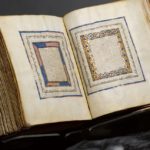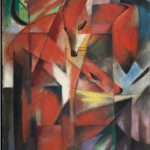
Laramie, WY.- When art dealer, Gayle B. Tate, was contacted by the estate of Emerson E. Glass, one can only imagine his surprise. The work of the previously unknown master of American impressionism that had laid hidden from the art world for over fifty years, came suddenly to light. It was not until the first shipment of paintings arrived at Mr. Tate’s office that he began to realize the significance of this offering. The paintings began to flow into his office only a few at a time, but with increasing quality, to the point where it was obvious that this was truly an undiscovered master. Mr. Tate had met the widow of the artist in 2003 in pleasant surroundings of tea and cake, but did not place much significance on it until she asked for another meeting in Kansas City, Missouri. During that meeting, Nina Glass spoke in rambling memories of her late husband’s work and their life together. Then, a year later, Mr. Tate received a call from a law office in Omaha, informing him of the choice by the artist’s deceased widow, that G. B. Tate & Sons Fine Art was named in her will to handle the artist’s estate. The work of Emerson Glass can found at the current show G. B. Tate & Sons Fine Art in Laramie, Wyoming through the end of October. The show is open to the public by appointment, or the works can be seen on the gallery’s website.
Among the artist’s few associates was his friend, Birger Sandzen, who is widely recognized in the art world for his own contributions to American impressionism. The work of E. E. Glass bears certain similarities to that of Sandzen, but with a greater attention to detail and draftsmanship. E. E. Glass worked with both brush and a tight palette knife technique that is unique to himself in the world of art. Why has the artist’s work never surfaced? Mr. Glass was deformed in a house fire when a youth. He lost his parents in the fire and was raised in the deep south by a plantation worker. He was always a recluse who shunned public exposure. Even his work reflects who he was, being of the high and lonely mountain ridges and hidden places of the Rocky Mountains. His work took him to Kansas, Nebraska, Colorado and Wyoming among other places. One can see the kind of place Glass preferred, evident in their isolation or time of day. His paintings of the night and moon are an important part of his production, which are again a reflection of isolation and seperation. Also, the artist often painted the storms and tornados of the midwest plains, logically reflecting his own turmoil. Yet the paintings of E. E. Glass are filled with hope and energy, despite his life circumstances. Colors are applied very liberally and beautifully interacted in his strong impressionist techniques. His subjects, often the wind blown pines of the high ridges are carefully and dramatically drafted to show their character… that of survivors against the “storms of life”.

Emerson Glass was born in poverty and died in poverty, having never sold a painting. Glass’s father was a foreman on a cotton plantation in the deep south, near the town of Clinton, Louisiana. At the age of seven, a fire destroyed the boy’s home and his father and mother died in the blaze. Emerson himself was badly burned and scarred for life on the left side of his face and upper body… leaving him scarred in more ways than one. A plantation worker took the young boy in and cared for him till he left home at the age of 23. “Mammi Jax” was a black woman, born and raised as a plantation slave and served as cook for the master of the plantation. The deformed Emerson Glass was worth little more than an object of abuse in southern society, even for a white boy… but to Mammi Jax, he was the son she never had, a gift from above. For the rest of the world, a boy with no education, no social acceptance and no hope for the future… EE Glass was a castaway. No one noticed the foundation of an exceptional talent… no one except Mammi Jax. She could see the pain in the young Emerson, and always spoke to the boy as if he was the Prince of Baton Rouge, destined for greatness. Even though he never saw the kind of success most folks dream of, it never seemed to matter much to young Emerson. But Mammi Jax was there to gently push the boy toward his destiny.
At the age of 13, the great depression hit this country like those freight trains that roared through Clinton but never stopped. Nonetheless, despite the lack of education, Emerson found ways to make his own colors… from red clays and roots and berries, to rocks and bits of cloth ground into pigments, Glass rubbed his rudimentary pigments together and stored them in jars, spreading them onto cardboard panels with twigs and branches. With Mammi Jax behind him, young Emerson did not work in the fields or the kitchen, but spent his days gathering materials and sitting alone under the trees of southern Louisiana and Mississippi. He would get off by himself for days at a time, spreading his handmade colors on bits of cardboard and shirt stuffers he was given from grocery stores and laundry services. He knew nothing of government help for artists during the years of FDR and the WPA. He simply worked alone in fields, far from civilization and the pain of exposure to society. When Mammi Jax died, Glass was 23, and had never seen a real painting, never met an artist, never been to a museum or gallery and never read an art book. Yet in Montgomery, Alabama, Emerson Glass found his first exposure… a show of the great impressionists at the new Museum of Fine Art. He wept for days in delight at the sight of the great masters… Pierre-Auguste Renoir, Claude Monet, Camille Pissarro and the rest of the early modernist movements. Color just for the sake of color became a new source of passion for Glass. He took jobs washing dishes and sweeping floors so he could buy colors he had never seen before. Slowly but surely, he grew in skill and determination to paint.
By the time he was 30, Glass was producing work that had matured into his unique style. In his travels, he crossed paths with William Henry Walker (American, 1871 – 1938), who spoke of Glass as an innovative post runner of the impressionists. He was invited to stay and study with Walker, but rejected it to avoid Walker’s frequent company and popularity. During his travels toward the west, Glass met Birger Sandzen in Lindsborg, Kansas, staying briefly to study with the artist before continuing toward the Rocky Mountains of Colorado and Wyoming. No further artists have been found to associate with the work of EE Glass, and he had no audience with which to share his vision. Because of his awkward appearance, he avoided public exposure and would not engage in social events so necessary for emerging artists of his day. No galleries, no patrons… destined for obscurity for the rest of his life. In 1954, Emerson met Nina Brandt. The couple seemed like a perfect if not serendipitous match, for she was blind and he was deformed. Under common law marriage, they lived together for the remainder of Emerson’s life, when he died of natural causes at the age of 71 in a tiny apartment in a rural area south of Kansas City, Missouri. What Nina did for Emerson was support his desire to see what she couldn’t… the wide spread horizon of the midwest and western United States, from the abundant wildlife and fields of corn and wheat of the plains to the majesty of the Rocky Mountains.

There is no evidence that they ever traveled east from the Mississippi River. Nina was able to obtain government disability support, most of which was used to buy paints, wooden panels and pay for travel expenses for she and her husband. In return, Emerson taught her to read Braille… this despite the fact that he could not read himself. Yet in his own words, he could “feel the language with her”, and they both learned from books without print. Little else is known about Emerson Glass. The only two people who figured in his life were Mammi Jax and Nina. No other person is named as instrumental in his history. Emerson never exhibited his work and as far as is known, never sold a painting. The fact that he and Nina lived in the barest of circumstances was never a hindrance to their happiness together and their privacy was just what they liked. Nina Glass died in March, 2007. Two years prior to her death, and having no children or other close relative, she entrusted the estate of her husband’s work to G. B. Tate & Sons Fine Art of Laramie, Wyoming. Nina and Tate were under agreement that no paintings would be displayed or offered for sale until after her death… for she could not allow even the potential for any further rejection of her husband, in the event the art world might not accept his work.
G. B. Tate & Sons Fine Art retired from public art gallery operations in 1997, and have since worked discretely and privately with our long standing and growing list of clientele for quality works of art. Visit their website at … http://www.gbtate.com







